Abstract
In unanaesthetized fetal lambs at 125-135 days gestation in utero central acidosis caused by perfusion of the cerebral ventricular system with a solution containing less than 1 mM-HCO3- (cerebrospinal fluid (c.s.f.) pH 6.98) or intravenous infusion of ammonium chloride (c.s.f. pH 7.1) produced an increase in the depth and frequency of episodic breathing but no change in electrocortical activity, heart rate or arterial pressure. Administration of prostaglandin synthetase inhibitors, sodium meclofenamate (0.8-10 mg/kg I.V. or 0.6-2.6 mg/kg intracerebrally) or acetylsalicylic acid (6.7 mg/kg I.V.) caused prolonged episodes of fetal breathing during low and high voltage electrocortical activity, with a large increase in breath amplitude. Blood gas values, heart rate, blood pressure, electrocortical activity and eye movements were not altered. In fetuses whose brain stems had been sectioned in the upper pons or the inferior colliculus, sodium meclofenamate induced prolonged deep breathing. Intravenous prostaglandin E2 abolished the continuous breathing induced by meclofenamate, but not breathing movements enhanced by hypercapnia or hypoxia. It is concluded that the central chemoreceptors respond to acidosis in near-term lamb fetuses qualitatively as in adult animals. Secondly, the results suggest that prostaglandin E2 and the inhibitors of prostaglandin synthesis also act centrally in the lower pons or medulla to modulate fetal breathing.
Full text
PDF
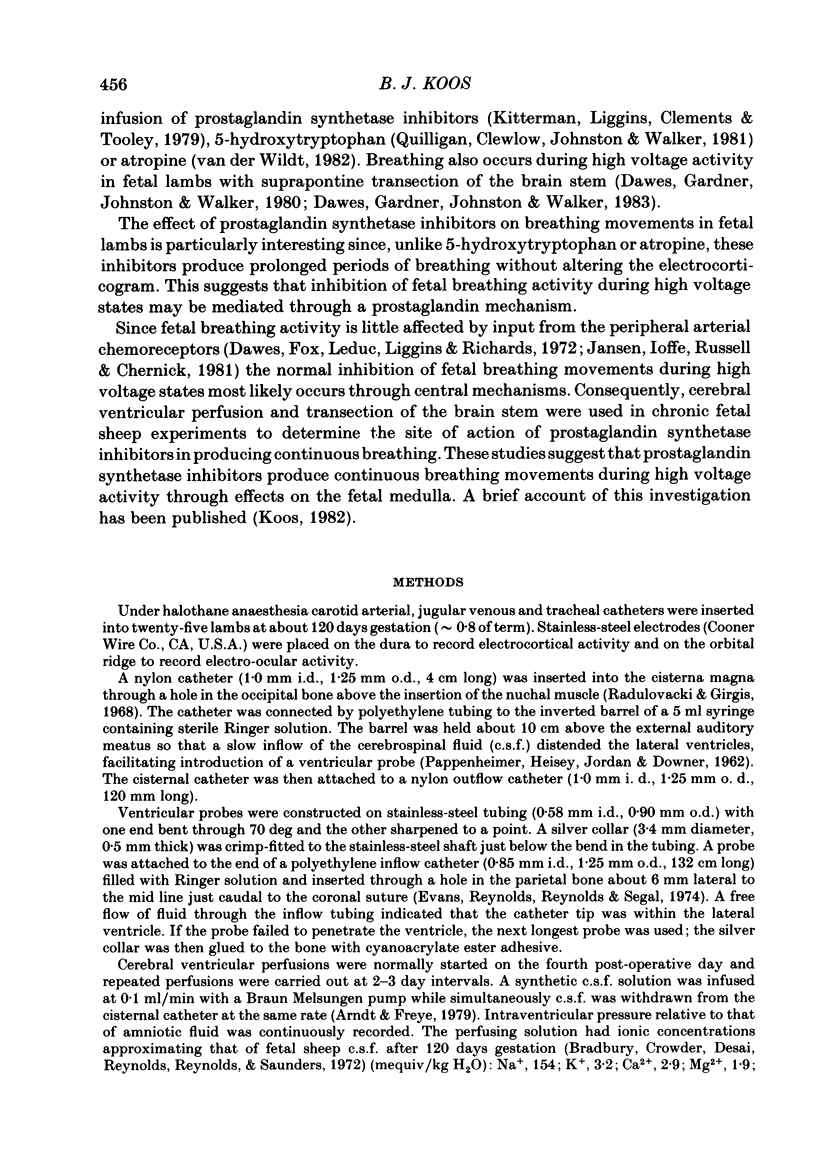
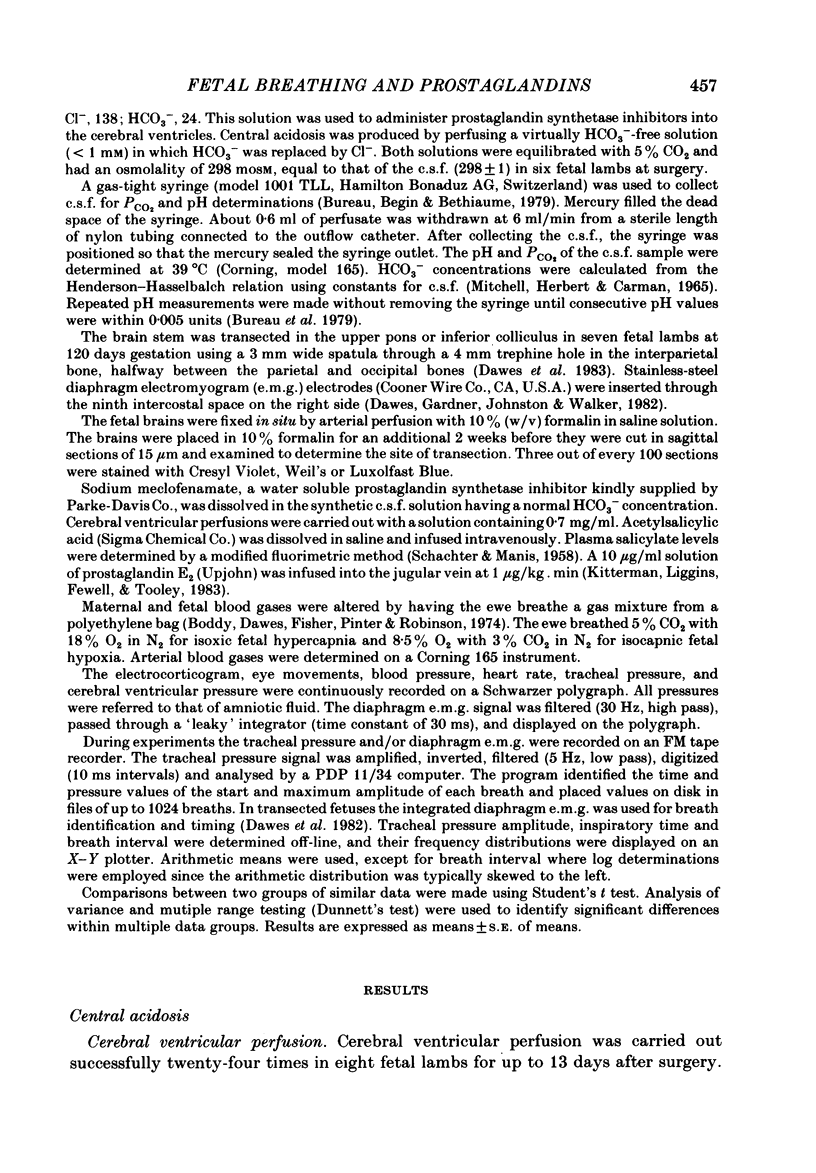
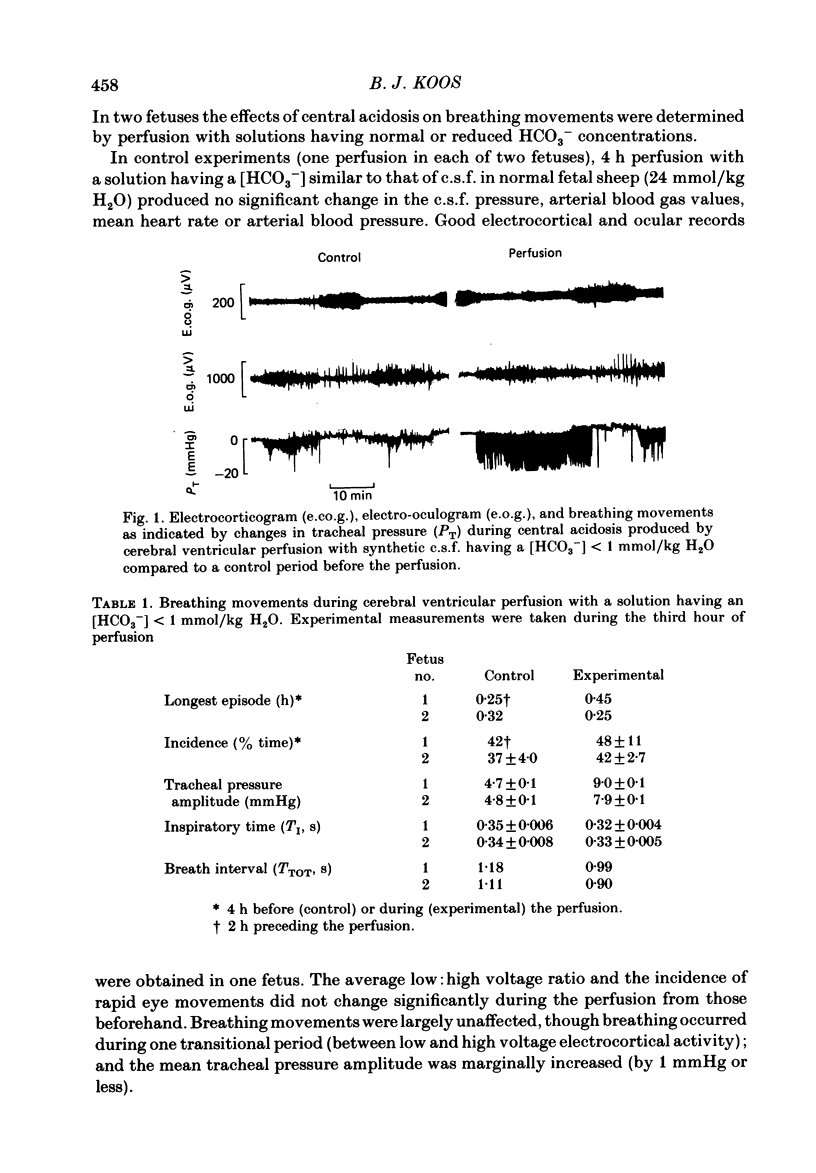
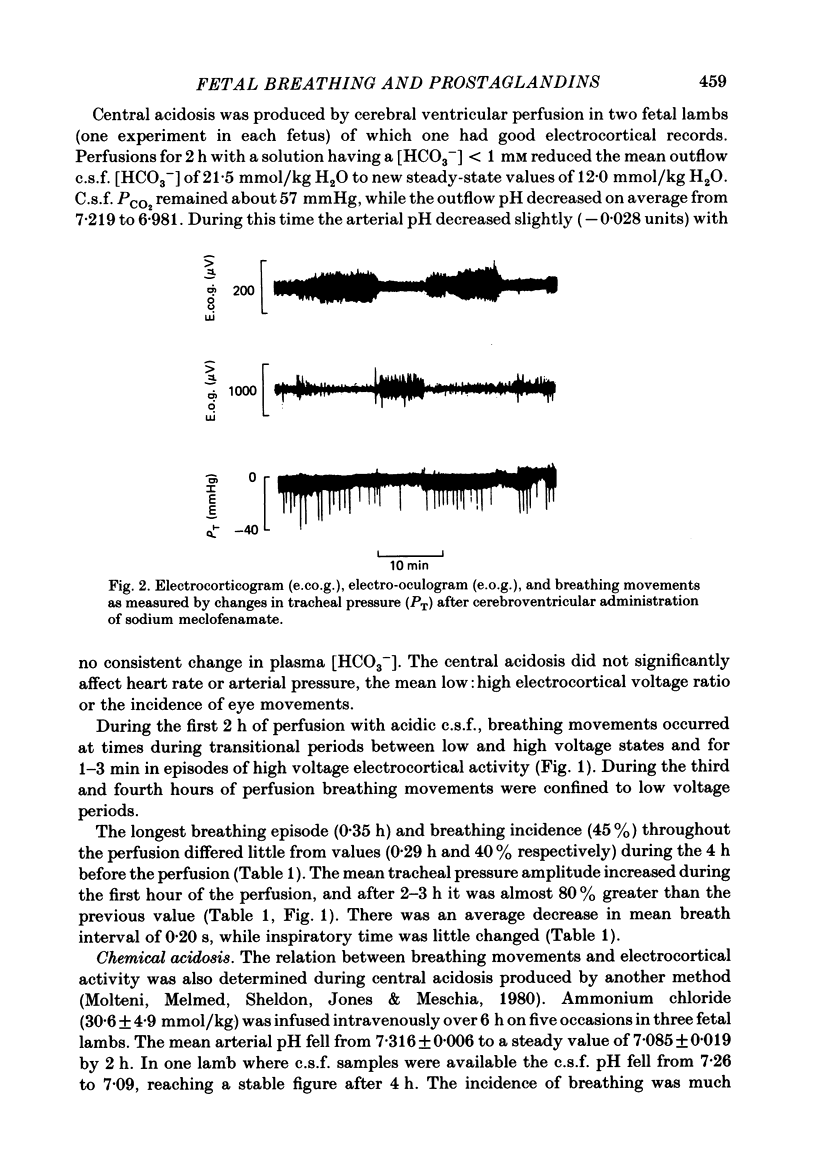
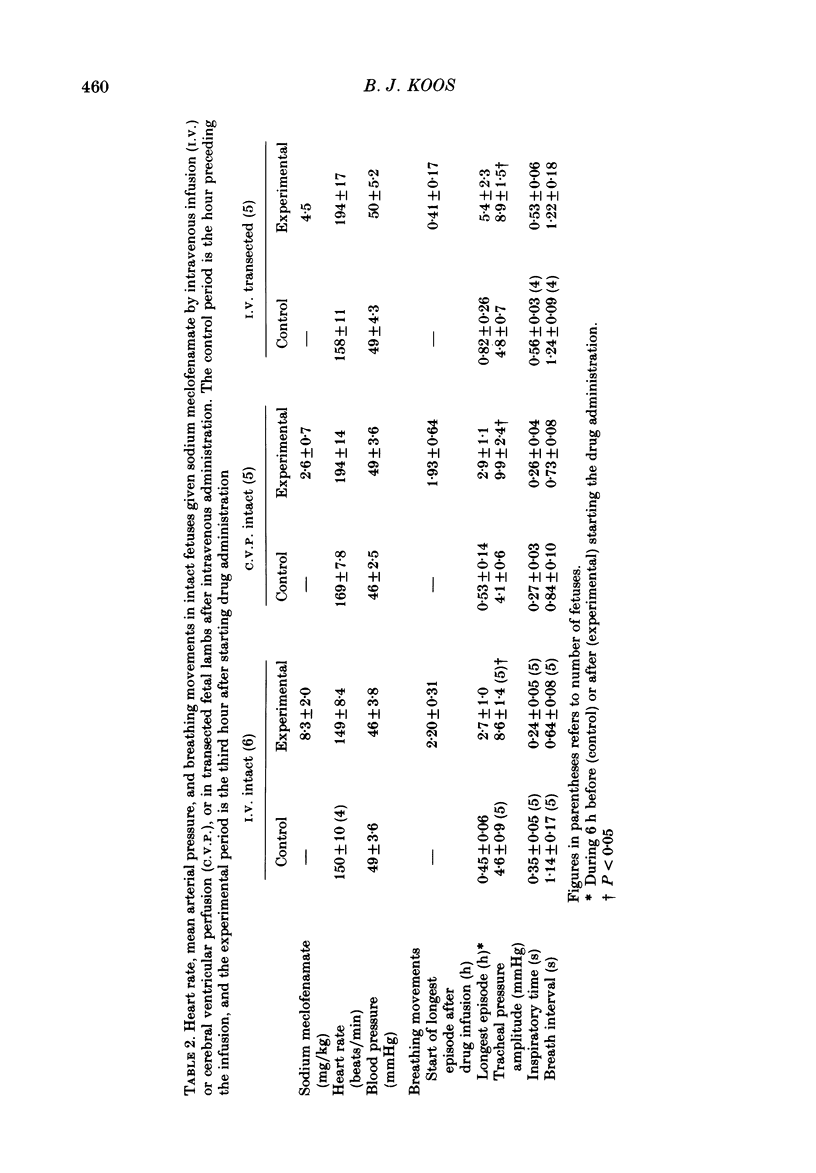
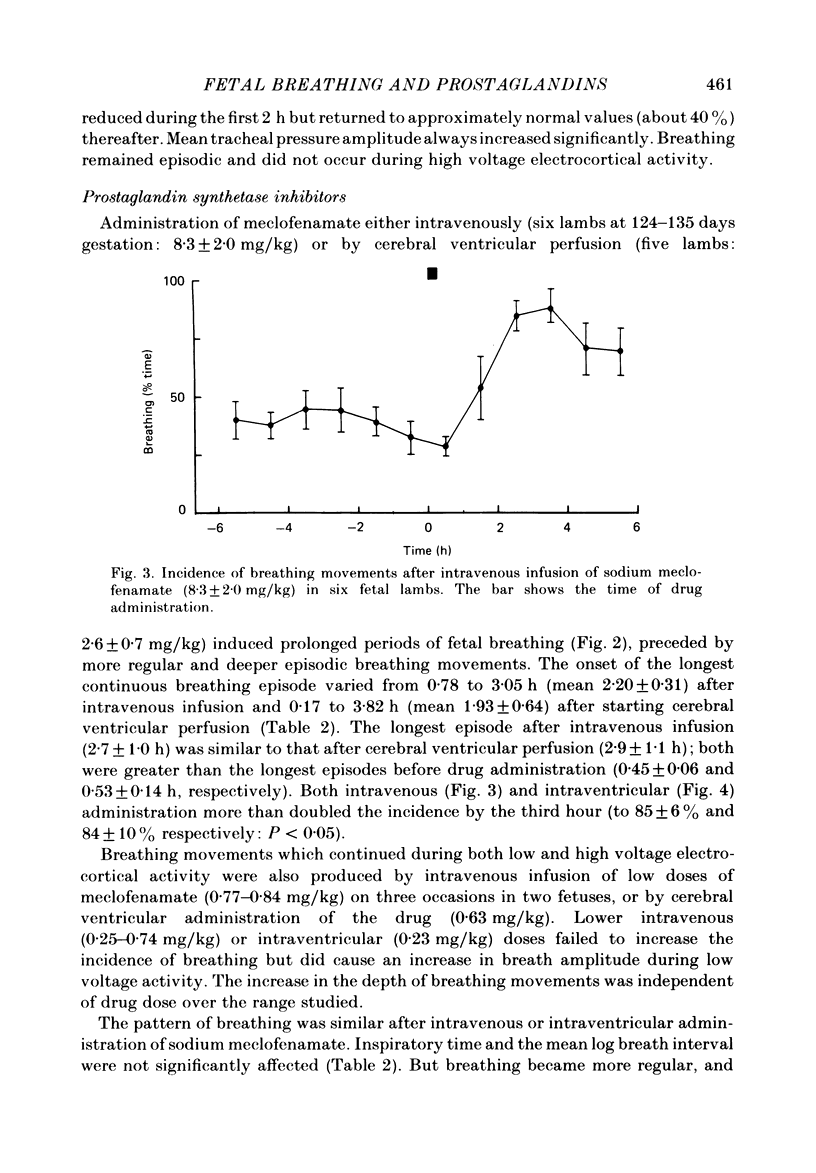
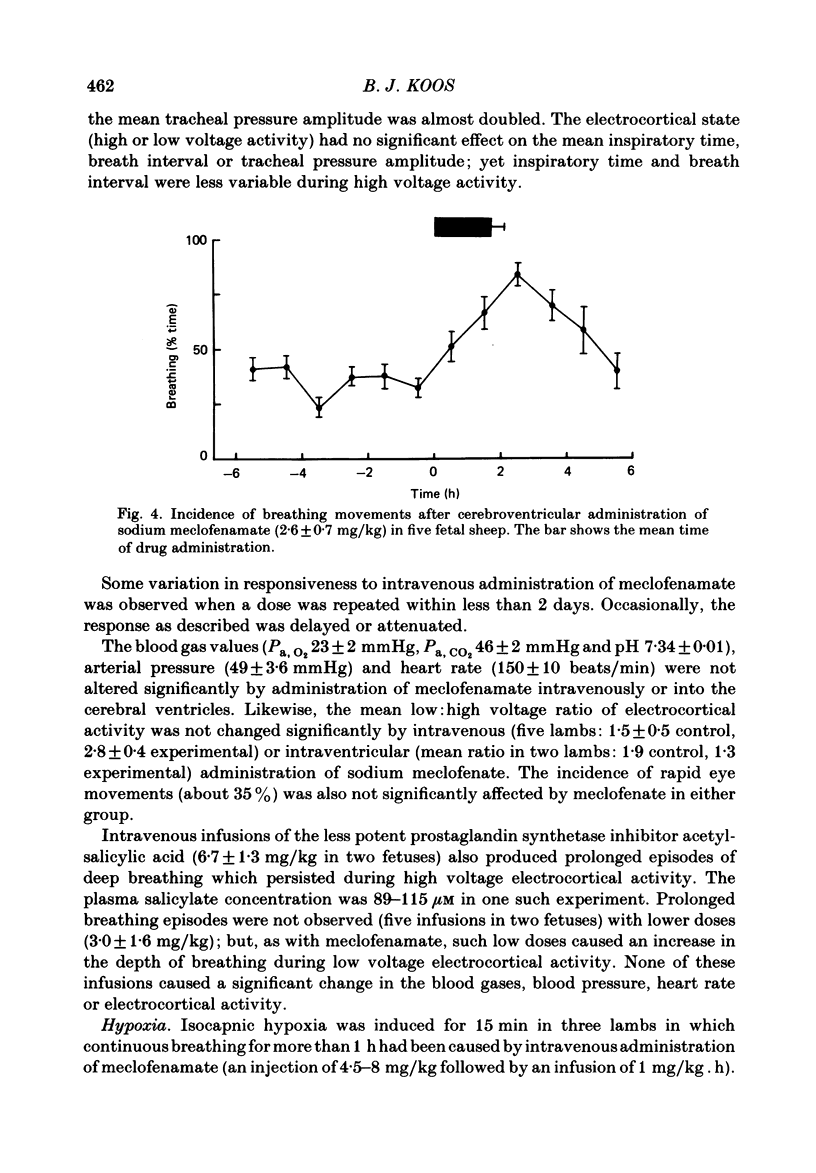
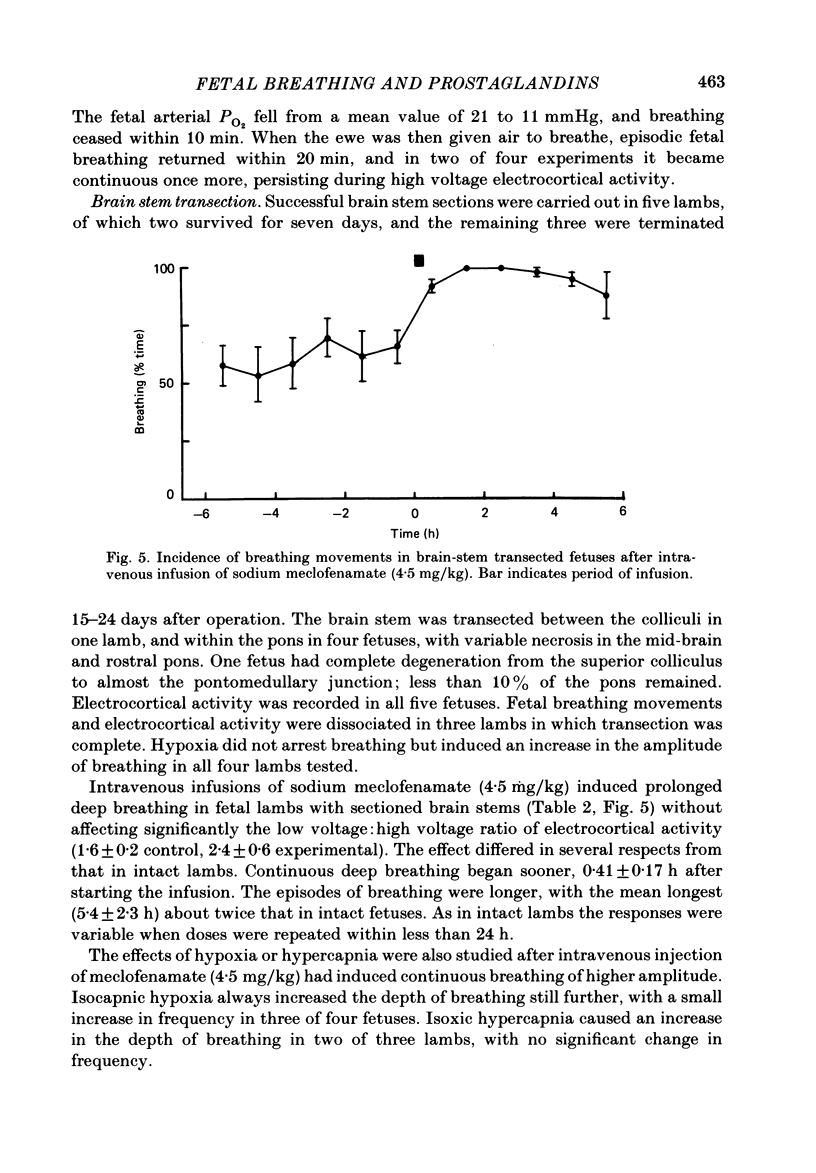
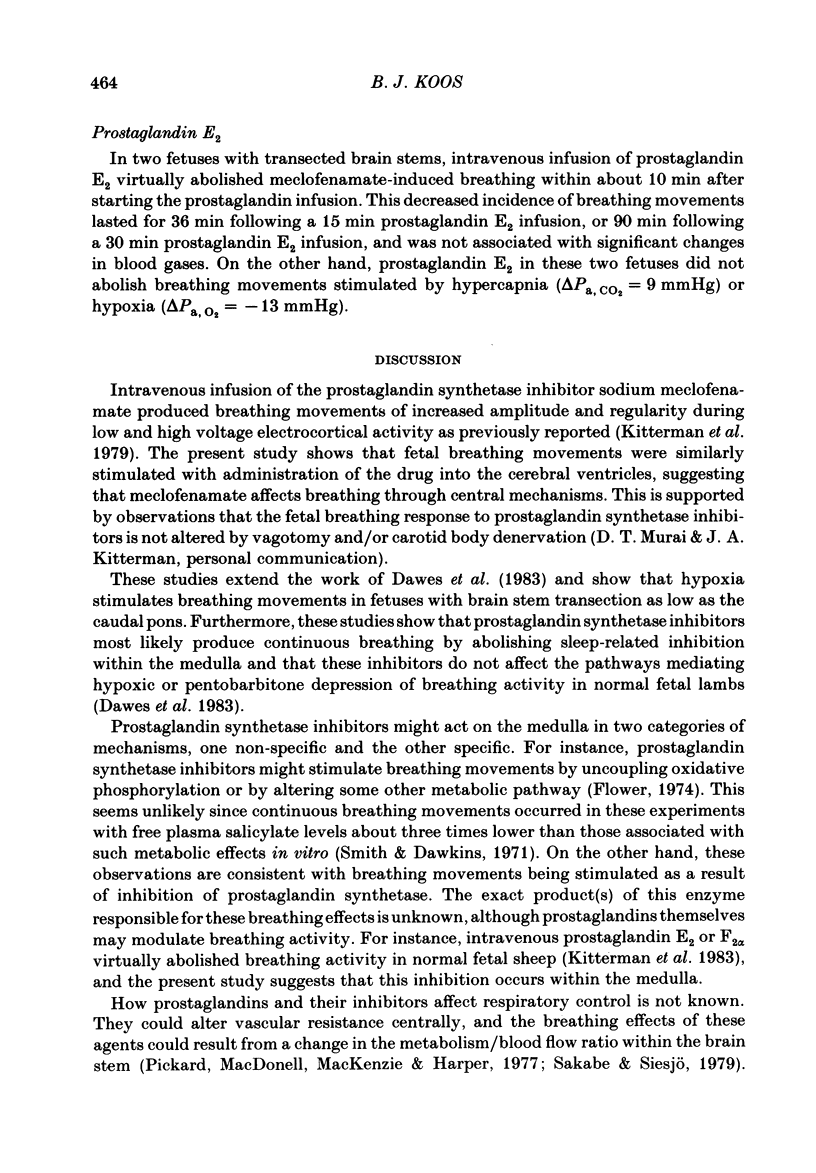
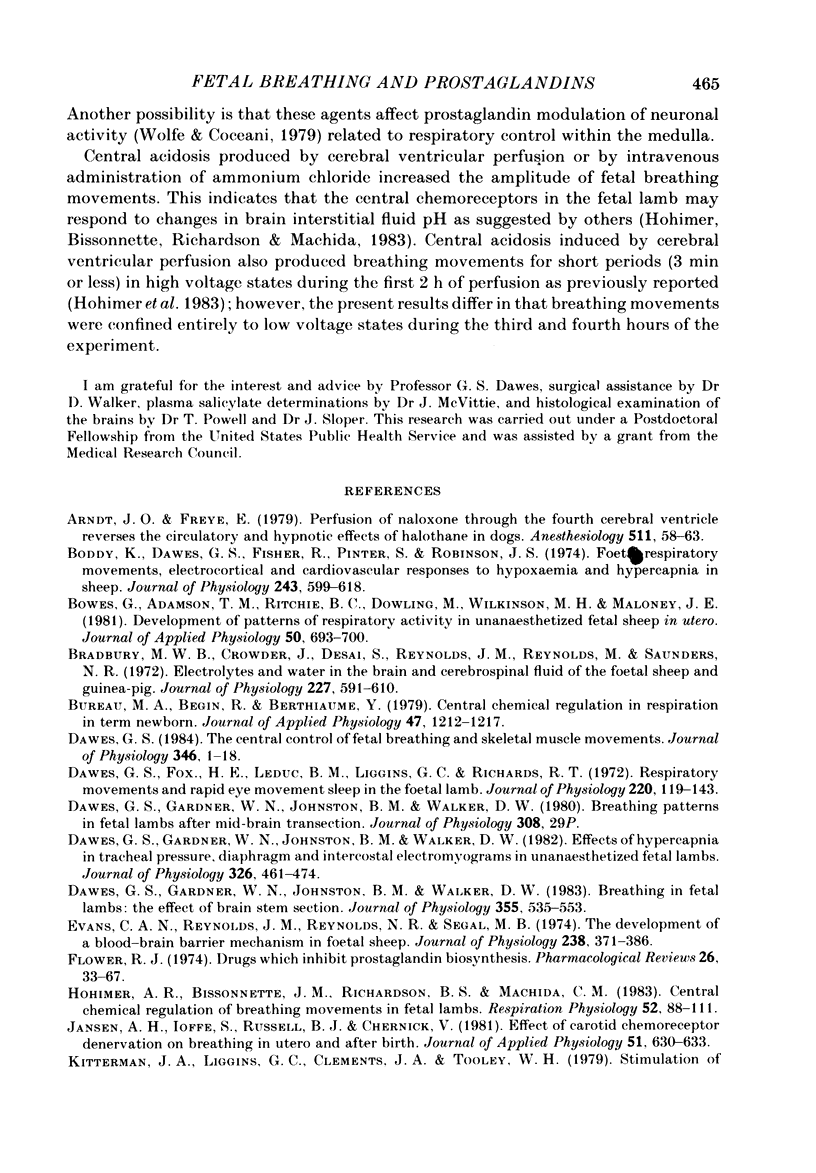
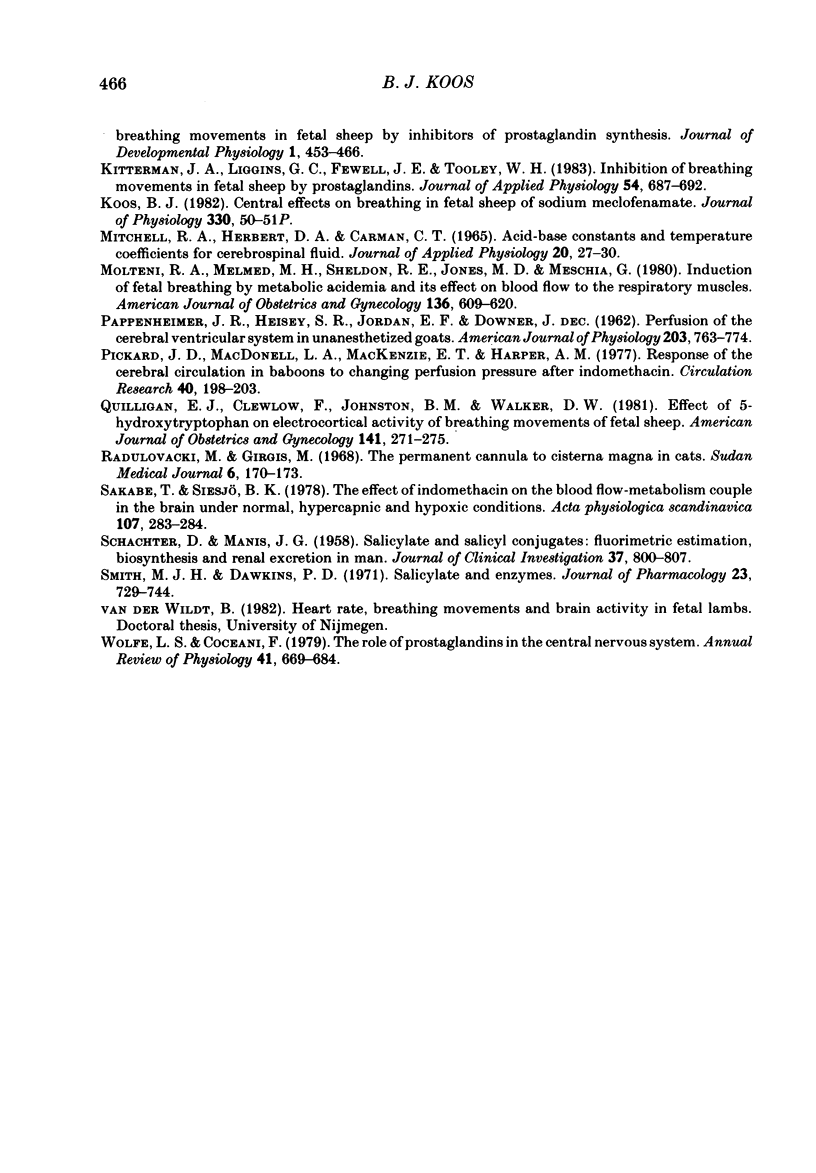
Selected References
These references are in PubMed. This may not be the complete list of references from this article.
- Arndt J. O., Freye E. Perfusion of naloxone through the fourth cerebral ventricle reverses the circulatory and hypnotic effects of halothane in dogs. Anesthesiology. 1979 Jul;51(1):58–63. doi: 10.1097/00000542-197907000-00013. [DOI] [PubMed] [Google Scholar]
- Bloom S. R., Edwards A. V., Järhult J. The effect of somatostatin on pancreatic endocrine responses mediated via the parasympathetic innervation in the conscious calf. J Physiol. 1980 Nov;308:29–38. doi: 10.1113/jphysiol.1980.sp013459. [DOI] [PMC free article] [PubMed] [Google Scholar]
- Boddy K., Dawes G. S., Fisher R., Pinter S., Robinson J. S. Foetal respiratory movements, electrocortical and cardiovascular responses to hypoxaemia and hypercapnia in sheep. J Physiol. 1974 Dec;243(3):599–618. doi: 10.1113/jphysiol.1974.sp010768. [DOI] [PMC free article] [PubMed] [Google Scholar]
- Bowes G., Adamson T. M., Ritchie B. C., Dowling M., Wilkinson M. H., Maloney J. E. Development of patterns of respiratory activity in unanesthetized fetal sheep in utero. J Appl Physiol Respir Environ Exerc Physiol. 1981 Apr;50(4):693–700. doi: 10.1152/jappl.1981.50.4.693. [DOI] [PubMed] [Google Scholar]
- Bradbury M. W., Crowder J., Desai S., Reynolds J. M., Reynolds M., Saunders N. R. Electrolytes and water in the brain and cerebrospinal fluid of the foetal sheep and guinea-pig. J Physiol. 1972 Dec;227(2):591–610. doi: 10.1113/jphysiol.1972.sp010049. [DOI] [PMC free article] [PubMed] [Google Scholar]
- Bureau M. A., Bégin R., Berthiaume Y. Central chemical regulation of respiration in term newborn. J Appl Physiol Respir Environ Exerc Physiol. 1979 Dec;47(6):1212–1217. doi: 10.1152/jappl.1979.47.6.1212. [DOI] [PubMed] [Google Scholar]
- Dawes G. S., Fox H. E., Leduc B. M., Liggins G. C., Richards R. T. Respiratory movements and rapid eye movement sleep in the foetal lamb. J Physiol. 1972 Jan;220(1):119–143. doi: 10.1113/jphysiol.1972.sp009698. [DOI] [PMC free article] [PubMed] [Google Scholar]
- Dawes G. S., Gardner W. N., Johnston B. M., Walker D. W. Breathing in fetal lambs: the effect of brain stem section. J Physiol. 1983 Feb;335:535–553. doi: 10.1113/jphysiol.1983.sp014549. [DOI] [PMC free article] [PubMed] [Google Scholar]
- Dawes G. S., Gardner W. N., Johnston B. M., Walker D. W. Effects of hypercapnia on tracheal pressure, diaphragm and intercostal electromyograms in unanaesthetized fetal lambs. J Physiol. 1982 May;326:461–474. doi: 10.1113/jphysiol.1982.sp014206. [DOI] [PMC free article] [PubMed] [Google Scholar]
- Dawes G. S. The central control of fetal breathing and skeletal muscle movements. J Physiol. 1984 Jan;346:1–18. doi: 10.1113/jphysiol.1984.sp015003. [DOI] [PMC free article] [PubMed] [Google Scholar]
- Evans C. A., Reynolds J. M., Reynolds M. L., Saunders N. R., Segal M. B. The development of a blood-brain barrier mechanism in foetal sheep. J Physiol. 1974 Apr;238(2):371–386. doi: 10.1113/jphysiol.1974.sp010530. [DOI] [PMC free article] [PubMed] [Google Scholar]
- Flower R. J. Drugs which inhibit prostaglandin biosynthesis. Pharmacol Rev. 1974 Mar;26(1):33–67. [PubMed] [Google Scholar]
- Hohimer A. R., Bissonnette J. M., Richardson B. S., Machida C. M. Central chemical regulation of breathing movements in fetal lambs. Respir Physiol. 1983 Apr;52(1):99–111. doi: 10.1016/0034-5687(83)90139-1. [DOI] [PubMed] [Google Scholar]
- Jansen A. H., Ioffe S., Russell B. J., Chernick V. Effect of carotid chemoreceptor denervation on breathing in utero and after birth. J Appl Physiol Respir Environ Exerc Physiol. 1981 Sep;51(3):630–633. doi: 10.1152/jappl.1981.51.3.630. [DOI] [PubMed] [Google Scholar]
- Kitterman J. A., Liggins G. C., Clements J. A., Tooley W. H. Stimulation of breathing movements in fetal sheep by inhibitors of prostaglandin synthesis. J Dev Physiol. 1979 Dec;1(6):453–466. [PubMed] [Google Scholar]
- Kitterman J. A., Liggins G. C., Fewell J. E., Tooley W. H. Inhibition of breathing movements in fetal sheep by prostaglandins. J Appl Physiol Respir Environ Exerc Physiol. 1983 Mar;54(3):687–692. doi: 10.1152/jappl.1983.54.3.687. [DOI] [PubMed] [Google Scholar]
- MITCHELL R. A., HERBERT D. A., CARMAN C. T. ACID-BASE CONSTANTS AND TEMPERATURE COEFFICIENTS FOR CEREBROSPINAL FLUID. J Appl Physiol. 1965 Jan;20:27–30. doi: 10.1152/jappl.1965.20.1.27. [DOI] [PubMed] [Google Scholar]
- Molteni R. A., Melmed M. H., Sheldon R. E., Jones M. D., Meschia G. Induction of fetal breathing by metabolic acidemia and its effect on blood flow to the respiratory muscles. Am J Obstet Gynecol. 1980 Mar 1;136(5):609–620. doi: 10.1016/0002-9378(80)91012-1. [DOI] [PubMed] [Google Scholar]
- Pickard J. D., MacDonell L. A., MacKenzie E. T., Harper A. M. Response of the cerebral circulation in baboons to changing perfusion pressure after indomethacin. Circ Res. 1977 Feb;40(2):198–203. doi: 10.1161/01.res.40.2.198. [DOI] [PubMed] [Google Scholar]
- Quilligan E. J., Clewlow F., Johnston B. M., Walker D. W. Effect of 5-hydroxytryptophan on electrocortical activity and breathing movements of fetal sheep. Am J Obstet Gynecol. 1981 Oct 1;141(3):271–275. doi: 10.1016/s0002-9378(16)32632-1. [DOI] [PubMed] [Google Scholar]
- SCHACHTER D., MANIS J. G. Salicylate and salicyl conjugates: fluorimetric estimation, biosynthesis and renal excretion in man. J Clin Invest. 1958 Jun;37(6):800–807. doi: 10.1172/JCI103667. [DOI] [PMC free article] [PubMed] [Google Scholar]
- Sakabe T., Siesjö B. K. The effect of indomethacin on the blood flow-metabolism couple in the brain under normal, hypercapnic and hypoxic conditions. Acta Physiol Scand. 1979 Nov;107(3):283–284. doi: 10.1111/j.1748-1716.1979.tb06476.x. [DOI] [PubMed] [Google Scholar]
- Smith M. J., Dawkins P. D. Salicylate and enzymes. J Pharm Pharmacol. 1971 Oct;23(10):729–744. doi: 10.1111/j.2042-7158.1971.tb08598.x. [DOI] [PubMed] [Google Scholar]
- Wolfe L. S., Coceani F. The role of prostaglandins in the central nervous system. Annu Rev Physiol. 1979;41:669–684. doi: 10.1146/annurev.ph.41.030179.003321. [DOI] [PubMed] [Google Scholar]


